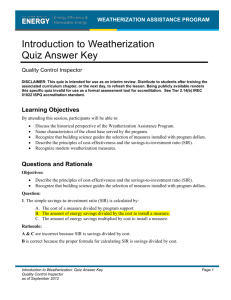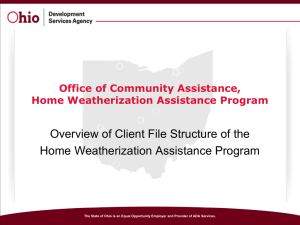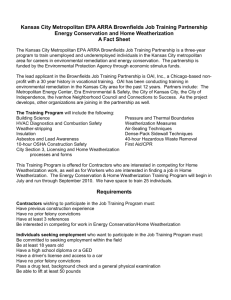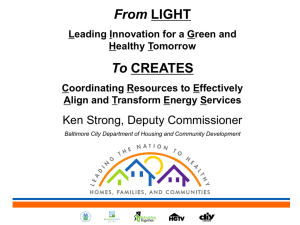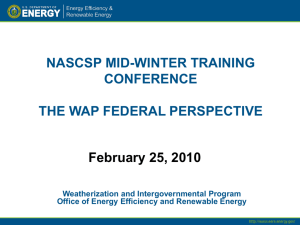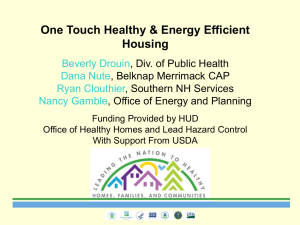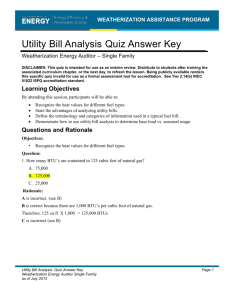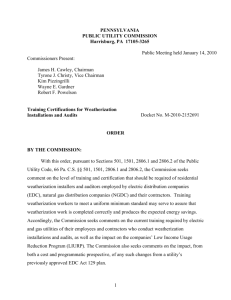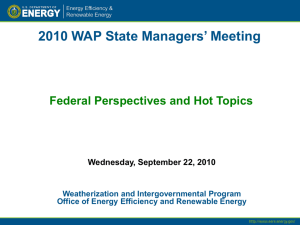The Weatherization Assistance Program (WAP) is the
advertisement
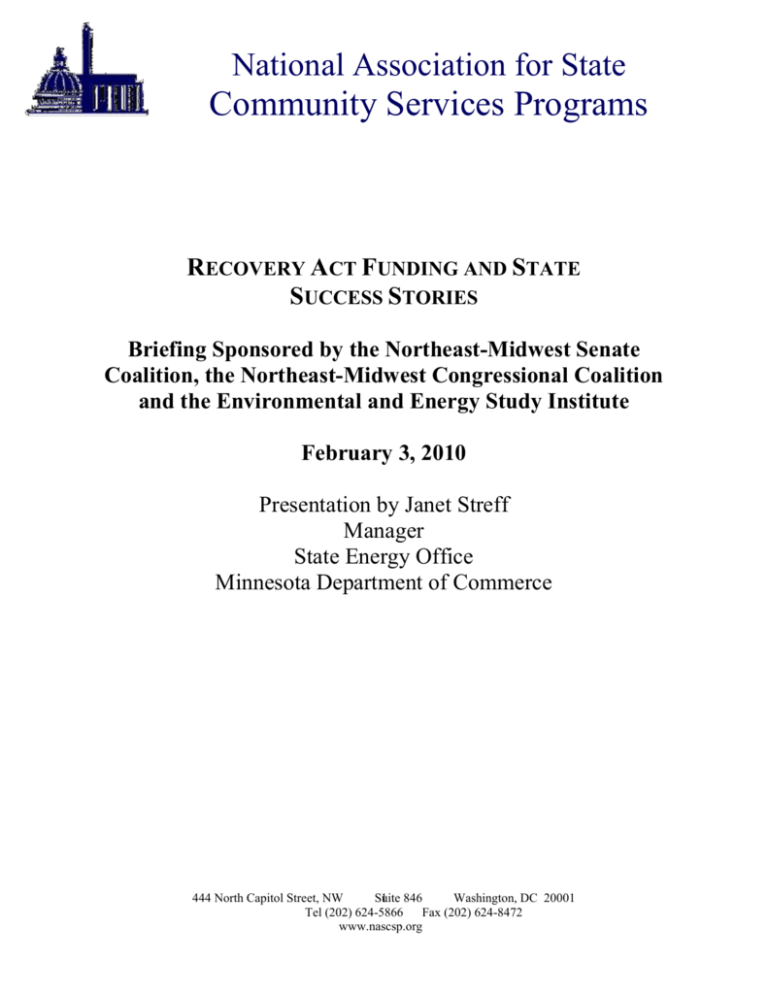
National Association for State Community Services Programs RECOVERY ACT FUNDING AND STATE SUCCESS STORIES Briefing Sponsored by the Northeast-Midwest Senate Coalition, the Northeast-Midwest Congressional Coalition and the Environmental and Energy Study Institute February 3, 2010 Presentation by Janet Streff Manager State Energy Office Minnesota Department of Commerce 444 North Capitol Street, NW Suite 1 846 Washington, DC 20001 Tel (202) 624-5866 Fax (202) 624-8472 www.nascsp.org National Association for State Community Services Programs The Weatherization Assistance Program (WAP) is the largest residential energy conservation program in the nation and serves a vital function in helping low-income families reduce their energy use. Developed as a pilot project in 1975, WAP was institutionalized in 1979 within DOE and is operated in all 50 states, the District of Columbia, U.S. Territories, and on Native American reservations. Network providers use program funds to improve the energy efficiency of low-income dwellings, utilizing the most advanced technologies and testing protocols available in the housing industry. Since the Program’s inception, more than 6.2 million homes have been weatherized using federal, state, utility and other monies. The American Recovery and Reinvestment Act of 2009 (ARRA) provided the Weatherization Assistance Program with an unprecedented level of funding: $5 billion over three years. As President Obama has noted, WAP is a three-fer: the Program trains and employs thousands of people for green-collar jobs, saves families money by saving energy, and reduces our dependence on foreign oil. An estimated 8,300 new jobs have been created by ARRA Weatherization Assistance Program funding – and more jobs are expected as states and local agencies finish the ramp up process. Approximately 590,000 homes occupied by low-income families will receive energy efficiency services with ARRA funds. This work will decrease home energy use as well as reduce monthly energy bills. Cutting down on energy usage provides a significant reduction in foreign oil imports by as much as 20 million barrels per year. The provision of these funds has allowed state and local agencies to significantly increase their efforts in the goal to weatherize hundreds of thousands of homes per year. The ramp-up to meet the production and expenditure requirements has been slower than expected, with valid reason. First, since its inception, WAP has had a waiver from the Department of Labor as far as compliance with Davis-Bacon Prevailing Wage requirements. This waiver does not apply to ARRA funds. While no members of the network dispute the need to pay a living wage to workers, the reporting requirements are substantial. It also required that a wage be determined for each weatherization position, making a wage survey necessary, which slowed down implementation of the program. While the wage survey was one of the fastest in 444 North Capitol Street, NW Suite 2 846 Washington, DC 20001 Tel (202) 624-5866 Fax (202) 624-8472 www.nascsp.org National Association for State Community Services Programs USDOL history, Prevailing Wage determinations first became available in August 2009, and were again revised at the end of December. Guidance for wage rates for use in large multi-family buildings of five stories or higher was released in November 2009. Second, State Historic Preservation rules state that any home built before 1950 must be evaluated for historic merit before any work is performed; however, many State Historic Preservations Offices (SHPOs) do not have the capacity to deal with the expanded number of homes that would fall under those rules with the WAP. Subsequently, some states have entered into agreements with their SHPOs, and it appears that a national agreement is imminent. Ultimately, while there have been some setbacks, the Weatherization network is ready to meet the expectations of the White House and weatherize hundreds of thousands of homes with Recovery Act dollars. The lead up has been slower than desired, but thousands of people have been trained, millions of dollars of equipment has been purchased, and millions of potential homes have been identified. We are ready to get to work. We have been busy in Minnesota. We received close to $132 million for low-income weatherization which will allow our 32 service providers to weatherize a minimum of 16,000 homes. The MN WAP received an award from UDOE in January for outstanding performance in the number of homes weatherized using ARRA funds. By the end of December – for the 4th quarter -- we had weatherized close to 1,400 homes with another 2,500 in progress. Our Minnesota program also reported the creation or retention of 346 jobs in the 4th quarter from ARRA funding for low-income weatherization. The jobs created were not only weatherization workers in the field; energy auditors and agency support staff also count themselves as benefactors of the stimulus funding. Florenda Cox, an energy conservation associate for the community action agency that serves Saint Paul and the surrounding counties, was hired in August. “My job is to help people understand how they can benefit from our program and to schedule their energy audits,” she said. “It’s a wonderful program for the community; it helps many people who otherwise couldn’t afford energy upgrades. It’s gratifying to know I can put a smile on someone’s face, helping them lower their energy bills.” 444 North Capitol Street, NW Suite 3 846 Washington, DC 20001 Tel (202) 624-5866 Fax (202) 624-8472 www.nascsp.org National Association for State Community Services Programs Joy Graf is support services supervisor at the same agency. She was laid off and did not work for 5 months before accepting her job at the agency in May 2009. “You hear on the news about all the people who have lost their jobs,” she said, “and some question the impact of the stimulus funding – they say it’s not helping. Well, we’ve hired 15 new people since I arrived, and most of those people had been out of work.” These are troubling times with our nation facing a lingering recession, high levels of unemployment, and falling spending rates. While these economic events create added financial burdens for all Americans, it’s especially hard for those who live at or below the poverty line. Low-income families have always spent a disproportionately large share of their income on energy needs than their middle-income counterparts. For example, a typical middle class family pays about 4 percent of their annual income for energy costs (heat, lights, air conditioning, appliances and hot water). Low-income families pay nearly the same dollar amount each year for energy but this amount represents a significantly higher percentage—16-20 % --of their total household income. In times of energy shortages and escalating energy costs, the energy burden for these families can reach 25 to 40 percent or more of their available income. The $5 billion allocated to WAP through ARRA was more than just a means to weatherize hundreds of thousands of low-income homes. It is also an important step in training workers and moving in the direction of creating a successful home energy retrofit market for all economic classes. If low-income weatherization has been successful, then is it not reasonable to expand it to a broader market so that more energy can be saved, more people can be employed, and an even greater reduction in carbon emissions can be achieved? This sound logic is picking up momentum. Weatherization is a clearly proven investment, which has helped over 6.2 million families live in safer, more comfortable living conditions. This is a program which has proved its worth and effectiveness for over thirty years. The additional Recovery Act money has given WAP the opportunity to ramp up the network. It is necessary to continue to provide adequate funding to continue these efforts for years to come. NASCSP supports the request for $300 million for WAP with the $30 million Innovation Fund as an addition to the initial amount. We also support $7.6 billion for 444 North Capitol Street, NW Suite 4 846 Washington, DC 20001 Tel (202) 624-5866 Fax (202) 624-8472 www.nascsp.org National Association for State Community Services Programs the Low Income Home Energy Assistance Program as well as $125 million for the State Energy Program, excluding the competitive portion. Rest assured that the funding invested in WAP, SEP and LIHEAP will provide essential services to thousands of low-income families, resulting in greater energy savings, more economic investments, increased leveraging of other funds and less reliance on highcost, foreign oil – outcomes that will benefit the nation. We in the Weatherization Assistance Program look forward to continued partnerships in the future as we attempt to create energy self-sufficiency and good jobs for millions of American families through these invaluable national programs. 444 North Capitol Street, NW Suite 5 846 Washington, DC 20001 Tel (202) 624-5866 Fax (202) 624-8472 www.nascsp.org

